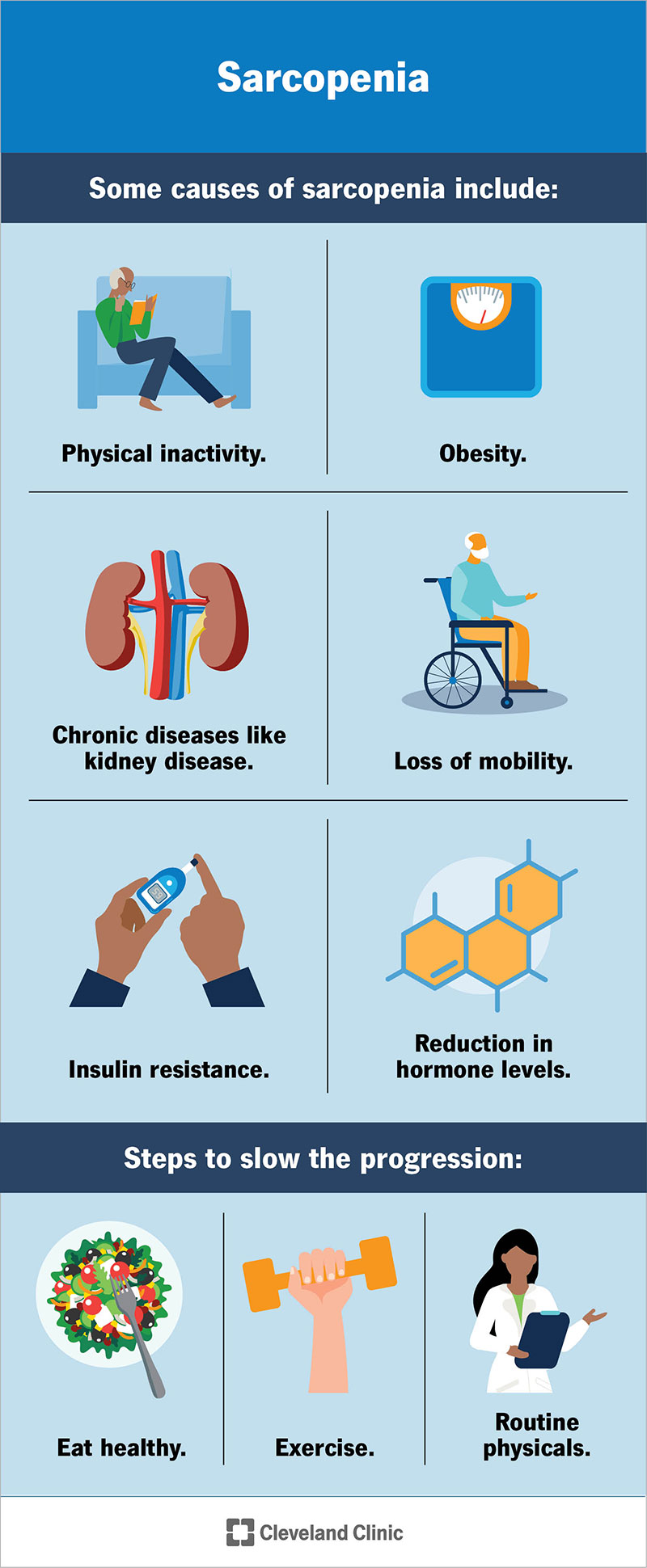Sarcopenia is the age-related progressive loss of muscle mass and strength. The main symptom of the condition is muscle weakness. Sarcopenia is a type of muscle atrophy primarily caused by the natural aging process. Scientists believe being physically inactive and eating an unhealthy diet can contribute to the disease.
Advertisement
Cleveland Clinic is a non-profit academic medical center. Advertising on our site helps support our mission. We do not endorse non-Cleveland Clinic products or services. Policy
The medical definition of sarcopenia is the gradual loss of muscle mass, strength and function. The condition commonly affects the elderly population and is thought to occur due to aging. Sarcopenia can greatly impact your quality of life by reducing your ability to perform daily tasks. It can lead to the loss of your independence and the need for long-term care.
Advertisement
Cleveland Clinic is a non-profit academic medical center. Advertising on our site helps support our mission. We do not endorse non-Cleveland Clinic products or services. Policy
Sarcopenia affects your musculoskeletal system and is a major factor in increased frailty, falls and fractures. These conditions can lead to hospitalizations and surgeries, which increase the risk of complications including death.
Sarcopenia can also affect people with a high body mass index (BMI), in a condition called sarcopenic obesity. People with obesity and sarcopenia have a greater risk for complications than with obesity or sarcopenia alone.
Sarcopenia most commonly affects people ages 60 and older. The rates increase with age. The disease affects both sexes equally. Studies on affected ethnicities are inconsistent. The rates of the condition increase in people with chronic disease.
Studies are inconsistent, and many people don’t receive a diagnosis or treatment for sarcopenia. But rates of the condition range from 5% to 13% in people ages 60 and older. The estimates increase to 11% to 50% in people ages 80 and older.
A decrease in both the number and size of your muscle fibers causes your muscles to thin (muscle atrophy).
As you age, your body goes through certain changes that play a major factor in developing sarcopenia. For instance, your body doesn’t produce the same amount of proteins your muscles need to grow. When this happens, your muscle cells get smaller.
Advertisement
In addition, as you grow older, changes in certain hormones — like testosterone and insulin-like growth factor (IGF-1) — affect your muscle fibers. This can lead to sarcopenia.

The most common symptom of sarcopenia is muscle weakness. Other symptoms may include:
The most common cause of sarcopenia is the natural aging process. You gradually begin losing muscle mass and strength sometime in your 30s or 40s. This process picks up between the ages of 65 and 80. Rates vary, but you may lose as much as 8% of your muscle mass each decade. Everyone loses muscle mass over time, but people with sarcopenia lose it more quickly.
Although aging tends to be the dominant factor, researchers have discovered other possible risk factors for sarcopenia. These may include:
Your healthcare provider may diagnose sarcopenia after performing a physical exam and asking you about your symptoms. You may complete a questionnaire based on your self-reported symptoms called the SARC-F. SARC-F stands for:
You score each factor with a number between 0 and 2. The highest maximum SARC-F score is 10. A SARC-F score of 4 or more warrants more testing.
There is no single test that can diagnose sarcopenia. Your healthcare provider may recommend several tests to diagnose and then determine the severity of sarcopenia.
Advertisement
Treatment for sarcopenia typically includes lifestyle changes. These modifications to your lifestyle behaviors can treat and help reverse sarcopenia.
Researchers are studying the possibility of using hormone supplements to increase muscle mass. But there aren’t currently any FDA-approved medications to treat sarcopenia.
The outlook for sarcopenia primarily depends on your age. Rates of the condition increase as you grow older. In addition, the outlook for the condition varies based on your health and lifestyle.
Advertisement
The disease can greatly affect your quality of life. You may be able to reverse the effects of the condition with lifestyle changes. If you don’t make recommended changes, the disease will continue to weaken your muscles. Over time, you may need full-time care to live your life.
You may not be able to completely prevent sarcopenia since the condition happens as part of the natural aging process. But you can take steps to slow the progression of the disease. These include:
In 2016, the Centers for Disease Control and Prevention (CDC) declared sarcopenia a specific disease by creating an International Classification of Disease (ICD) 10 code for the condition. This designation made sarcopenia a reportable disease by healthcare providers. Therefore, it increased the diagnosis and treatment of the disease. This label helps distinguish sarcopenia from similar diseases and allows researchers to begin collecting valuable data about the condition.
Advertisement
Sarcopenia is a type of muscle atrophy that specifically affects people as they grow older. Muscle atrophy is the loss of muscle tissue. The two conditions share common features of muscle loss, but the processes behind them are different. A decrease in the size and number of your muscle fibers causes sarcopenia. With muscle atrophy, there’s a reduction in the size of the fibers, but the amount of fibers stays the same.
Everyone experiences some amount of muscle loss as they age. But with sarcopenia, this muscle loss happens faster. The good news is, there are ways to treat and even reverse the effects of the condition. If you’ve experienced muscle weakness, loss of endurance or any other symptoms of sarcopenia, call your healthcare provider. They can diagnose the condition and develop a treatment plan for you to revert the muscle loss and improve your condition.
Whether you’re 50 or 90, it’s important to stay on top of your health and well-being. Cleveland Clinic offers the expert geriatric care you need — at all stages.

Last reviewed on 06/03/2022.
Learn more about the Health Library and our editorial process.